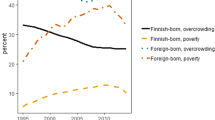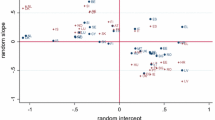Abstract
This study presents a detailed look at the immigration and internal migration dynamics of child poverty for US States based on the 1990 US census. It assesses the impact of two policy-relevant factors on the migration of poor children across States: (1) the role of high immigration levels as a potential “push” for native-born and longer-term resident poor children whose parents may be reacting to the economic competition or social costs in high immigration States; and (2) the role of State AFDC benefits as a potential “pull” for poor children who migrate with their parents to States with higher benefit levels. The results make plain that the interstate migration patterns of poverty children differ from those of nonpoverty children, especially among whites and blacks. Female-headed households show different inter-state migration patterns than those in married-couple households. However, a multivariate analysis which includes standard state-level economic attributes provides more support for an “immigration push” than for a “welfare magnet pull” in affecting the inter-state migration of poor children. The findings also show a demographic displacement of poor children occurring in high immigration States where the net out-migration of poor children is more than compensated by larger numbers of new immigrant children in poor families with different demographic attributes. Because of these migration dynamics, the demographic profile of the child poverty population will differ across States, suggesting the need for different strategies toward reducing child poverty at the State level.
Similar content being viewed by others
REFERENCES
Barringer, Herbert R., Gardner, Robert W., Levin, Michael J. (1993). Asians and Pacific Islanders in the Untied States, A 1980 Census Monograph. New York: Russell Sage.
Beck, Roy. (1996). The case against immigration. New York: Norton.
Blank, Rebecca M. (1988). The effect of welfare and wage levels on the location decisions of female-headed households.” Journal of Urban Economics, 24, 186-211.
Borjas, George J. (1994). The economics of immigration. Journal of Economic Literature, 3, (December), 1667-1717.
Broder, David S. (1995). A race to the bottom? The Washington Post National Weekly Edition, August 14–20, p. 4.
Cebula, Richard J. (1979). A survey of the literature on the migration-impact of state and local Policies, Public Finance, 34(1), 39-84.
Cebula, Richard J. & Belton, Willie J. (1994). Voting with one's feet: An empirical analysis of public welfare and migration of the American Indian, 1985–1990, American Journal of Economics and Sociology, 53(3), 273-280.
Chavez, Linda. (1995). What to do about immigration? Commentary, March, pp. 29-35.
Children's Defense Fund. (1995). The state of America's children yearbook, 1995. Washington, DC.
Clark, Rebecca. (1991). Does welfare affect migration? Washington, DC: The Urban Institute.
Cushing, Brian J. (1993). The effect of the social welfare system on metropolitan migration in the U.S., by income group, gender and family structure, Urban Studies, 30(2), 325-338.
Duncan, Greg J. & Brooks-Gunn, Jeanne (Eds.). Growing up poor. New York: Russell Sage Foundation.
Filer, Randall K. (1992). The effect of immigrant arrivals on migratory patterns of native workers, in George J. Borjas and Richard B. Freeman (Eds.). Immigration and the work force, pp. 245-269. National Bureau of Economic Research. Chicago: University of Chicago Press.
Fix, Michael & Passel, Jeffrey. (1994). Immigration and immigrants' setting the record straight, Washington, DC: The Urban Institute.
Frey, William H. (1994). The new white flight. American Demographics, April, pp. 40-48.
Frey, William H. (1995a). The new geography of US population shifts: Trends toward balkanization. In Reynolds Farley (Ed.). The state of the union: Social trends, pp. 271-336. New York: Russell Sage.
Frey, William H. (1995b). Immigration and internal migration ‘flight’: A California case study. Population and Environment, 16(4), 353-375.
Frey, William H. (1995c). Immigration and internal migration ‘flight’ from US metro areas: Toward a new demographic balkanization, Urban Studies 32, (May), 733-757.
Frey, William H. (1995d). Immigration impacts on internal migration of the poor: 1990 census evidence for US states, International Journal of Population Geography, 1(1), 51-67.
Frey, William H. (1996). Immigration, domestic migration and demographic balkanization in America, Population and Development Review, 22(4).
Frey, William H. & Speare, Jr., Alden (1988). Regional and metropolitan growth and decline in the United States. A 1980 Census Monograph. New York: Russell Sage.
Frey, William H., Liaw, K-L., Xie, Y., & Carlson, M.J. (1996). Interstate migration of the US poverty population: Immigration ‘pushes’ and welfare magnet ‘pulls.’ Population and Environment 17,(6), 491-536.
Gramlich, Edward M. & Laren, Deborah S. (1984). Migration and income redistribution responsibilities, Journal of Human Resources, 19, 489-511.
Hanson, Russell L. & Hartman, John T. (1994). Do welfare magnets attract? Institute for Research on Poverty, Discussion Paper No. 1028-94, University of Wisconsin-Madison.
Hirschman, Charles. (1995). Problems and prospects of studying immigration adaptation from the 1990 population census: From generational comparisons to the process of becoming American, International Migration Review 28(4), 690-713.
Hogan, Dennis & Lichter, Daniel T. (1995). Children and youth living arrangements and welfare. In Reynolds Farley (Ed.). State of the Union: Social trends, pp. 271-336. New York: Russell Sage.
Jensen, Lief & Chitose, Yoshami (1995). Today's second generation: Evidence from the 1990 US census. International Migration Review 28(4), 714-735.
Johnson, James H., Jr. & Roseman, Curtis. (1990). Increasing black outmigration from Los Angeles: The role of household dynamics and kinship systems. Annals of the American Association of American Geographers, 80(2), 205-222.
Lansing, John B. & Mueller, Eva. (1964). The geographic mobility of labor. Ann Arbor: Institute for Social Research.
Long, Larry. (1988). Migration and residential mobility in the United States. A 1980 Census Monograph. New York: Russell Sage.
Martin, Philip & Midgley, Elizabeth. (1994). Immigration to the United States: Journey to an uncertain destination. Population Bulletin, 49(2). Washington, DC: Population Reference Bureau.
Martin, Susan Forbes. (1993). The commission on immigration reform, Migration World, XXI(2 2/3), 43-44.
MacMahon, Walter W. & Chang, Shao-Chung. (1991). Geographical cost of living differences: InterState and intrastate, update 1991. MacArthur/Spencer Series Number 20. Illinois State University: Center for the Study of Educational Finance.
McHugh, Kevin E. (1987). Black migration reversal in the United States. Geographical Review 77, 171-187.
Moffitt, Robert. (1992). Incentive effects of the US welfare system. Journal of Economic Literature, 30(1), 1-61.
Peterson, Paul E. & Rom, Mark C. (1990). Welfare magnets. Washington, DC: The Brookings Institution.
Portes, Alejandro (Ed.). (1996). The new second generation. New York: Russell Sage.
Rumbaut, Rueben G. & Cornelius, Wayne A. (Eds.). (1995). California's immigrant children. San Diego: Center for US-Mexican Studies, University of California, San Diego.
Schram, Sanford F. & Krueger, Gary. (1994). Interstate variation in welfare benefits and the migration of the poor: Substantive concerns and symbolic responses. Institute for Research on Poverty Discussion Paper No. 1032-94. University of Wisconsin-Madison.
Simon, Julian. (1996). Public expenditures on immigrants to the United States, past and present. Population and Development Review, 22(1), 99-109.
Southwick, Lawrence, Jr. (1981). Public welfare programs and recipient migration. Growth and Change, (October), pp. 22-32.
Voss, Paul R., Corbett, Thomas, & Randell, Richard. (1992). Interstate migration and public welfare: The migration decision-making of a low income population. In Patrick C. Jobes, William F. Stinner & John M. Wardwell (Eds.). Community, Society and Migration: Noneconomic Migration in America, pp. 111-147. Lanham, MD: University Press of America.
Walker, Robert, Ellis, Mark, & Barff, Richard. (1992). Linked migration systems: Immigration and internal labor flows in the United States. Economic Geography, 68, 234-248.
Walker, James R. (1994). Migration among low-income households: Helping the witch doctors reach consensus. Institute for Research on Poverty Discussion Paper No. 1031-94. University of Wisconsin-Madison.
White, Michael J. & Hunter, Lori. (1993). The migratory response of native-born workers to the presence of immigrants in the labor market. Presented at 1993 meetings of the Population Association of America, Cincinnati (April).
Author information
Authors and Affiliations
Rights and permissions
About this article
Cite this article
Frey, W.H. Immigration, Welfare Magnets and the Geography of Child Poverty in the United States. Population and Environment 19, 53–86 (1997). https://doi.org/10.1023/A:1024697515511
Issue Date:
DOI: https://doi.org/10.1023/A:1024697515511




